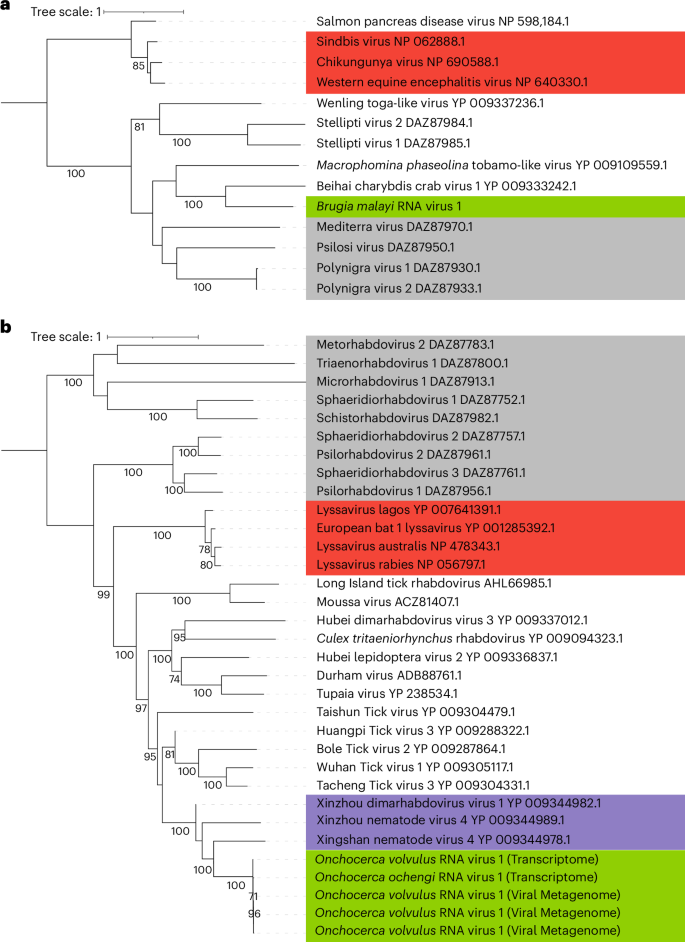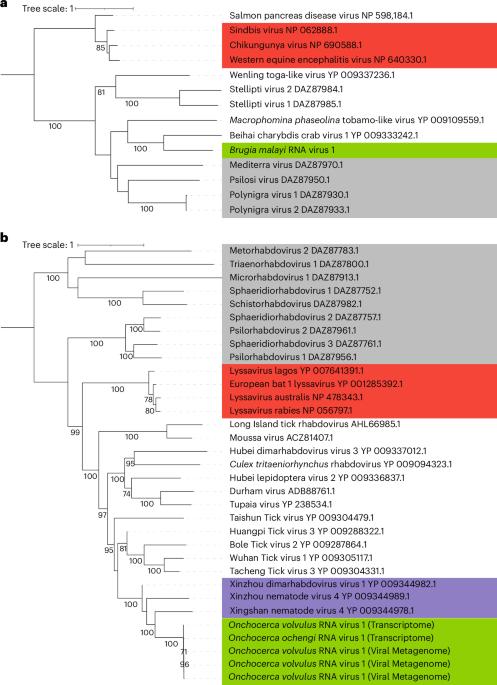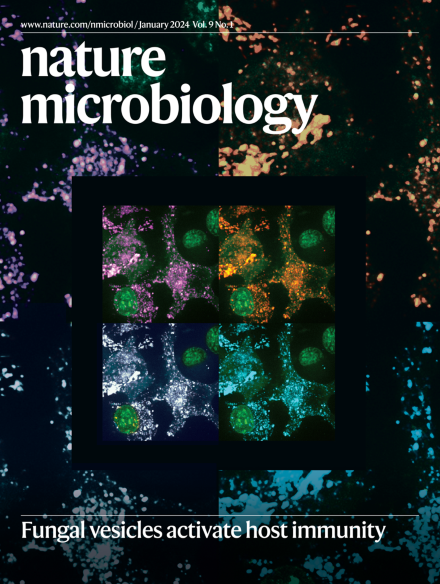寄生线虫的多种 RNA 病毒可引起脊椎动物宿主的抗体反应
IF 20.5
1区 生物学
Q1 MICROBIOLOGY
引用次数: 0
摘要
寄生线虫与脊椎动物组织有着密切、长期和终生的接触。在这里,我们从脊椎动物宿主中挖掘了 41 个已发表的寄生线虫转录组,在约 70% 的寄生线虫物种(41 个物种中有 28 个物种)中发现了 24 个科 13 个病毒目中的 91 种 RNA 病毒,其中仅包括 5 种以前报道过的病毒。我们观察到病毒与线虫的关联广泛分布于多个大洲,这表明存在祖先获取病毒的事件以及宿主与病毒的共同进化。对马来布鲁氏菌(BMRV1)和盘尾丝虫病(OVRV1)病毒的特性分析表明,这些病毒大量存在于成年寄生虫的生殖组织中。重要的是,马来线虫寄生虫中 BMRV1 RNA 的存在会引发针对 BMRV1 的 RNA 干扰反应,这表明病毒复制活跃。最后,研究发现 BMRV1 和 OVRV1 能在受感染的鸟类和受感染或暴露的人类血清样本中引起抗体反应,这表明病毒直接暴露于免疫系统。本文章由计算机程序翻译,如有差异,请以英文原文为准。


Diverse RNA viruses of parasitic nematodes can elicit antibody responses in vertebrate hosts
Parasitic nematodes have an intimate, chronic and lifelong exposure to vertebrate tissues. Here we mined 41 published parasitic nematode transcriptomes from vertebrate hosts and identified 91 RNA viruses across 13 virus orders from 24 families in ~70% (28 out of 41) of parasitic nematode species, which include only 5 previously reported viruses. We observe widespread distribution of virus–nematode associations across multiple continents, suggesting an ancestral acquisition event and host–virus co-evolution. Characterization of viruses of Brugia malayi (BMRV1) and Onchocerca volvulus (OVRV1) shows that these viruses are abundant in reproductive tissues of adult parasites. Importantly, the presence of BMRV1 RNA in B. malayi parasites mounts an RNA interference response against BMRV1 suggesting active viral replication. Finally, BMRV1 and OVRV1 were found to elicit antibody responses in serum samples from infected jirds and infected or exposed humans, indicating direct exposure to the immune system. Transcriptome mining, phylogenetic analysis, bioimaging and serology experiments reveal a widespread diverse virome present in ~70% of parasitic nematodes, such as Brugia malayi and Onchocerca volvulus, where some viruses are abundant in the reproductive tract and are associated with seropositivity in vertebrate hosts.
求助全文
通过发布文献求助,成功后即可免费获取论文全文。
去求助
来源期刊

Nature Microbiology
Immunology and Microbiology-Microbiology
CiteScore
44.40
自引率
1.10%
发文量
226
期刊介绍:
Nature Microbiology aims to cover a comprehensive range of topics related to microorganisms. This includes:
Evolution: The journal is interested in exploring the evolutionary aspects of microorganisms. This may include research on their genetic diversity, adaptation, and speciation over time.
Physiology and cell biology: Nature Microbiology seeks to understand the functions and characteristics of microorganisms at the cellular and physiological levels. This may involve studying their metabolism, growth patterns, and cellular processes.
Interactions: The journal focuses on the interactions microorganisms have with each other, as well as their interactions with hosts or the environment. This encompasses investigations into microbial communities, symbiotic relationships, and microbial responses to different environments.
Societal significance: Nature Microbiology recognizes the societal impact of microorganisms and welcomes studies that explore their practical applications. This may include research on microbial diseases, biotechnology, or environmental remediation.
In summary, Nature Microbiology is interested in research related to the evolution, physiology and cell biology of microorganisms, their interactions, and their societal relevance.
 求助内容:
求助内容: 应助结果提醒方式:
应助结果提醒方式:


